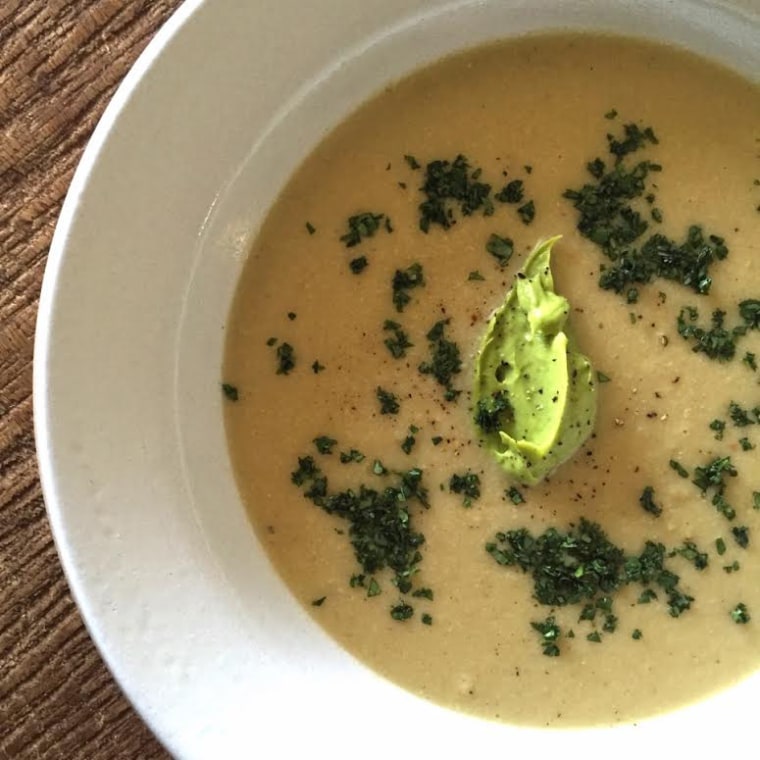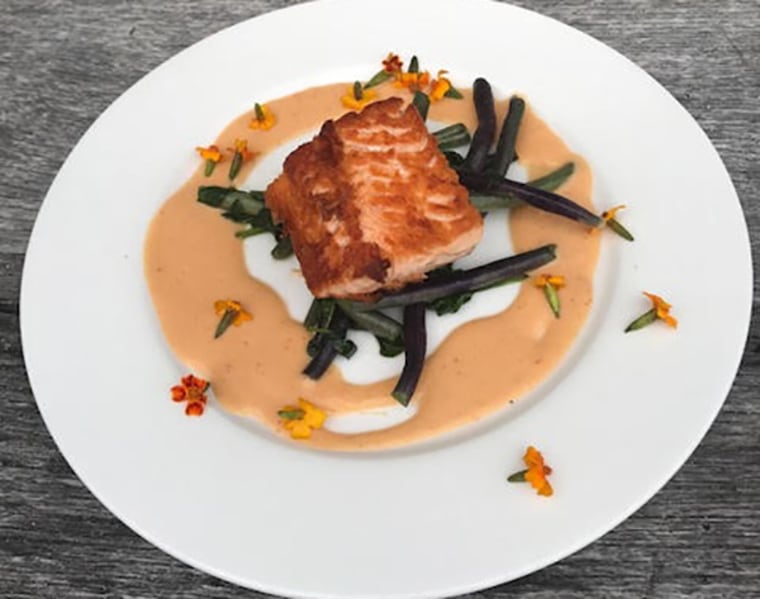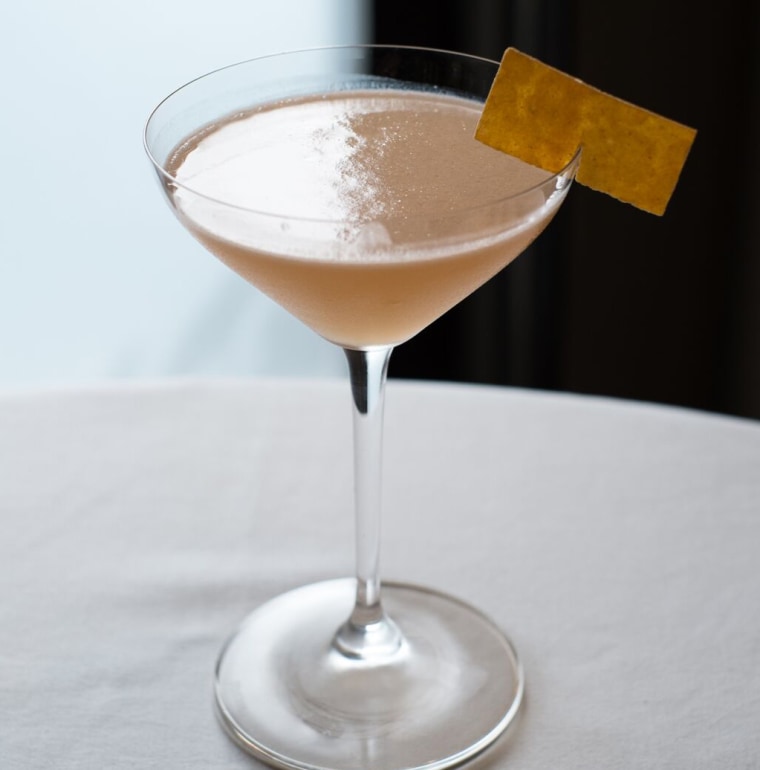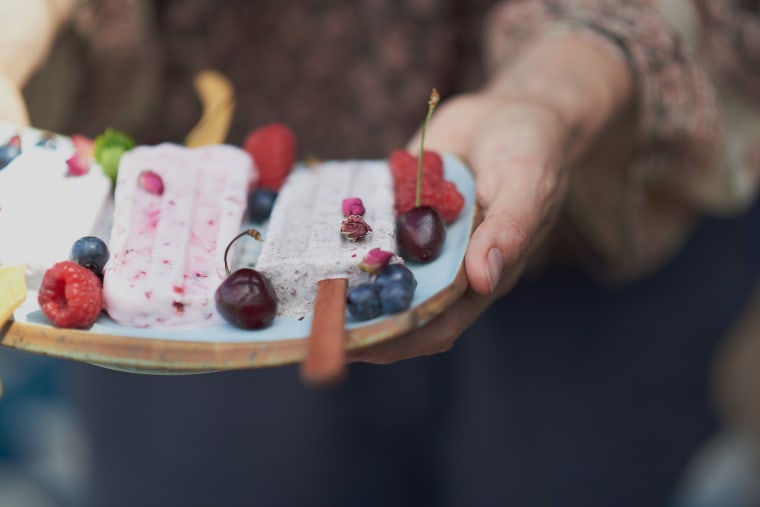Recently, my fiancé and I resolved to start cooking more.
The motivation was to save money and also to eat healthier. While these goals have been met, I’ve noticed a disturbing trend taking root in our kitchen: the trash bin is filling with an awful lot of food scraps.
We may be eating better, but we’re not doing any good for the planet (which according to the Food and Agriculture Organization is suffering as a result of our food waste). I wanted to minimize my waste, so I chatted with several chefs to learn of possible ways I could be using the scraps I was chucking, and my mind was promptly blown. Just about everything I’ve been perceiving as garbage is salvageable. Not only can these formerly landfill-bound food bits be cooked up into something delicious, but they pack a punch of nutrients.
If you’ve got some scraps lying around here’s how you can put them to culinary use!
‘Puree’ Magic: Veggie Stalks, Corn Cobs and Radish Tops
Vegetable stalks are bland and tough to chew when raw, and so they often get tragically trashed. But they’re loaded with vitamins, and also flavor (when cooked properly); Chefs rely on them for savory purees.
“I love using vegetable scraps such as cauliflower, broccoli and fennel stalks to make delicious, fiber- and nutrient-rich puree soups,” said Dina Cheney, a cookbook author, recipe creator and food stylist.

I cook corn all the time, and I never gave much thought to the cob — a major food faux pas on my end. Celebrity chef Nathan Lyon uses corn cobs in his Creamed Summer Corn Soup with Chopped Cilantro and Avocado Puree.
“The humble corn cob holds so much sweet flavor that can be extracted by steeping them in soups or stocks,” said Lyon. “My corn soup is double the flavor because of the cobs.”
Another part of vegetables that often get unnecessarily tossed are the tops (think the weird little stems on carrots and radishes or the hard bases of greens). But they’re both edible and potentially yummy! When Lyon preps roasted carrots, he sets aside the tops to make Carrot Top Cilantro Puree. He also uses radish tops to fashion Radish Top and Red Pepper Salsa — ideal for ladling onto cod tacos.
“The ends of cabbages and lettuces can be grilled up for a nice grilled salad or shaved for a warm slaw,” added Chef Chad Sarno.
Use Bones For Broths and Stocks
Making fish or meat for dinner? Hang onto the bones.
“[Using] the carcass is a great way to take advantage of its nutritionally dense properties that are rich in minerals such as calcium and Phosphorous,” said Jose Guerrero, executive chef at ViewHouse, who cites his Bell Pepper & Corn Succotash Organic Pulled Chicken Salad as a favorite summer recipe. After simmering the chicken carcass, leftover corn cobs (another exquisite example of corn cob usage), green onions and parsley for 40 minutes, he chills it to create a fortified probiotic bone stock that can be consumed straight from the fridge.
Andre Pinto, head chef at Paisano’s Italian Restaurant inside Pechanga Resort & Casino advises utilizing would-be discarded fish bones to make fish stock for a future dish like linguini and clams.
“Fish bones will keep in an airtight container in the fridge for several days in case you can’t get to the linguini and clams recipe right away,” said Pinto, adding that it’s worthwhile to ask your local butcher if they have any leftover fish bones. “Some will give them to you for free.”
When you make the linguini and clams, Pinto notes that you can save the clam shells to make fish broth for yet another meal.

Overripe Fruits Are Perfect For Sweets and Dressings
Mushy, browning fruit may be no good for eating fresh, but it’s actually the best kind of fruit for making desserts.
“Cut off any blemishes and cook the fruit with a little sugar and lemon juice and you have a great filling for pies, crisps and cobblers,” said Justine Kelly, co-founder and executive chef at Sun Basket, a meal-kit delivery service that uses organic and sustainably sourced ingredients.
Marilyn Schlossbach, chef, restaurateur and owner of the Marilyn Schlossbach Group recommends turning those mushy peaches into a peach glaze by roasting the peaches and then blending them with sweet chili sauce, roasted onion, garlic, salt, pepper and your favorite herb, be it basil or cilantro. Put it in a squeeze bottle and voila!
“Drizzle on fish, chicken, veggies or use as a dressing for salad,” said Schlossbach, who uses peach glaze on organic farm raised salmon, served with Jersey purple beans and baby spinach.
And don’t forget the citrus peels. Kelly recommends using these to infuse olive oils, while Chef Deena Chanowitz says she uses lemon zest in her Green Goddess Salad Dressing and her Fresh Berry Popsicles.

Cheers to Pasta Water — With Whisky
You can also use egg whites and the water you used to cook pasta to make a waste-free cocktail.
Kim Stodel, the beverage director at Providence, says she crafted the cocktail "Carbonara Footprint," in part to put these commonly wasted foods to use. The concoction implements one egg white and .75 ounces of pasta water along with Angostura bitters, fresh lemon juice and bourbon.
Stodel also makes a lime cordial that has lime zest and celery root scraps among its ingredients, as well as a "Mano de Chango" (a hybrid of a margarita and a paloma) that uses guava pulp that may have otherwise gone to waste.
A Few More Quick Tricks
I’m eager to try out some of these recipes, but I also know I’m not going to make a peach glaze every time I encounter a dud peach in the kitchen or simmer a chicken carcass on a busy weeknight.
Fortunately, Michael Young, executive chef at Sheraton Kauai Resort shared some quick tips that we can all employ to be more conscientious cooks:
- Dice broccoli stems into cubes and microwave for three minutes. Add them to just about any veggie-friendly dish for a nutritional boost.
- Chop leftover herbs with a little extra virgin olive oil and garlic and then freeze in ice-cube trays for a reserve of pesto whenever you need it, mess-free.
- Toss potato peels with a little oil, salt and pepper and then bake for a healthy alternative to potato chips.
- Put tough outer greens from kale, chard or beet tops in an oven on low to dehydrate them. Then puree and you’ve got a homemade vitamin-packed powder to add to your morning green smoothie.
Another cool trick? Saving scraps for aromatic finishing oils.
“Save your herb and vegetable scraps to blend with a grapeseed or vegetable oil to make aromatic finishing oils,” said Zach Hunter, executive chef at the soon-to-open Austin, Texas eatery, The Brewer’s Table. “Blanch herbs in water for 90 seconds, shock in ice water and then blend with equal weight of oil in your blender or food processor to make all kinds of fun oils. Herbs that work great for this are basil, chive and dill. These oils will keep for a week or so in the fridge, or a couple months in the freezer.”
These finishing oils may be used as a secondary seasonings to enhance the final flavors of a dish, Hunter said, but adds that you can also use fruit and herbal scraps to make cleaning oils and soaps.
Wow! The food I was going to throw out can taste good, deliver nutrients and help the planet — and I can use them to smell good, too? I’m sold.
